#Alilat
Explore tagged Tumblr posts
Text
Alilat - Day 44
Race: Entity
Arcana: Empress
Alignment: Light-Chaos
June 13th, 2024

A personal favorite kind of demon throughout the series has to be the ones that are completely alien- demons that look like they originated from a psychological study, or living beings that, by all means, look like they shouldn't be real. Demons of this kind are surprisingly few and far between, with most appearing as rather standard depictions of monsters or humanoid beings, but when the artists dip their toes into the strange, almost beyond this world, I fall in love with the designs the instant I lay my eyes on them. One of these, of course, is today's Demon of the Day, and a strange outcast even among the strangest demons throughout the series- the ill-known Mother Goddess of the Arabian Peninsula, Alilat.
Mostly known by one of her many names, al-Lat, Alilat is a relatively obscure goddess in the grand scheme of history. As a pre-islamic goddess worshipped in Arabia, a lot of history surrounding her is hard to parse, even down to the exact areas that her reign was present within, but the general consensus appears to be that she was mainly worshipped in several widespread cults throughout Arabia during its pre-islamic days. Another name of hers, Allat, has actually been the name of several goddesses throughout several different areas in history as well, making her story even more confusing to dig through. The tangled webs of tales and future conflations between her and other deities make her an incredibly confusing deity to sift through the facts about.
Our first recorded mention of Alilat actually comes in the form of a retelling from Greek scholar Herodotus, who, in his book 'Histories' wrote,
"They believe in no other gods except Dionysus and the Heavenly Aphrodite; and they say that they wear their hair as Dionysus does his, cutting it round the head and shaving the temples. They call Dionysus, Orotalt; and Aphrodite, Alilat."
I will admit to copying that passage from Wikipedia, but I'm not about to sift through a copy of such a massive transcript to search for a single line. Interestingly, this transcription by Herodotus actually has a conflict with how most other people drew comparisons- it was commonly believed, and still is today, that Alilat was actually the ancient Arabian's version of Athena. As a goddess of motherhood and fertility, as well as peace, she shares some similar traits to Athena in greek myth, as they also both share a trait as a goddess of war. Where this came from is described in several Safaitic inscriptions, as she used to be invoked by travelers through the region in order to guarantee peace, prosperity, and protection, while warriors at the time would invoke her name to ensure good loot and those attacked would invoke her for vengeance. As one of two principal deities, she seemed to be stuck working overtime a lot.
This is also proven by how scattered her inscriptions are throughout Africa- there are only few given, and most of them are in vastly different areas, giving light to the idea that her cult was widespread but decentralized. And yes, it was a cult, not a formalized religion, as her worship was incredibly sparse. She was revered by many names and even more traditions, including a northern Arabian tribe known as the Qedarites, the widespread peoples of the Nabataeans, and even those residing within the largest Parthian city of its time, Hatra. A lost city known as Iram of the Pillars was also a home of Alilat worship, with them having erected a temple that has now been buried beneath the sands- tragically, all that has been left was a few pillars and a crumbled statue of a lion, but accounts and some small inscriptions on the inside of the temple revealed that it originally had a gorgeous statue of Alilat inside, resembling none other than Athena.


Unfortunately, as time went on, the temple fell into disrepair, having been the target of an attack from Greek forces, then utterly demolished in the fourth century by Christian mobs. You can read more about it on the blog I linked above. However, in terms of Mythology, there's still a bit more to go. Al-Lat wasn't just the deity of a cult, but also appears in Islamic tradition as well, fulfilling a similar purpose to Ba'al in some respects as a false god, though one depicted far more sympathetically. In some retellings, she's not even that, and is instead a daughter of Allah, or even a consort of his in others. Alilat was also the subject of the infamous Satanic Verses incident, something that is beyond the scope of this post, but is an incredibly interesting (and kinda hilarious) rabbit hole to dig through.
In the Book of Idols, an encyclopedia on pre-islamic religion in Africa written by scholar Hisham ibn al-Kalbi, it's written that a group of the Quraysh would chant a set of verses celebrating al-Lat, al-'Uzza, and Manat, of which al-Lat is our subject of interest. A common translation purports the word used to refer to them as a collective, gharaniq, to mean "Most exalted females," but this is hotly debated. Again, see the Satanic Verses incident. Lastly, she is mentioned in the Quran, albeit rarely, and, again, as the subject of the Satanic Verses incident. This is starting to feel like the noodle incident of this post.
I wish I could've shown her uncensored design, but alas, I have no idea if it'd pass the 'Female presenting nipple' guideline, but take it from me when I say that Alilat has an amazing design. Combining her esoteric and hard to sort through lore with her role as a mother goddess was a great call, as it makes her both unique and almost unsettling, even in this series rife with body horror. Even the titties, which I normally see no real point in having on a lot of designs and just feel like gratuitous fanservice (cough cough LAMIA) serve a purpose, as what does a mother do but breastfeed? The idea to portray her almost like a piece of art on a bizarre, floating obelisk was such a cool concept, and it was done perfectly.
I also love how the imagery associated with Alilat on the stone itself resembles stone-age portraits of how a body would look, more specifically the Venus of Willendorf, a famous sculpture that is typically used to represent fertility, tying it all together. Given that this inscription was also carved into stone in Alilat's design, and it ties everything together. Not only does her design look unique even for the series, not only does it tie so many ideas together in neat little bows, not only is it glowing, but it's all also brought together in representing one of the most mysterious and interesting gods in history, and demons in the series.
#shin megami tensei#smt#megaten#persona#daily#alilat#al-lat#also hey i'm deciding to add more persona theming to this blog!!!#going forward i'm gonna be including the arcana as well#where applicable ofc#still mostly gonna be smt focused dw#just wanted to branch out a bit#and make the blog more accessible to persona fans as well cus like. its in the tags lmao
19 notes
·
View notes
Text
yknow i wasn't even planning on posting this so i guess take this as a "don't drink and drive post" psa but anyway. i was on the mod page for smtv and there's a curvy (read: this man has never seen a woman before) mod for every single female demon in the game so i'm moving every one of them to "i'm gay and judging you." even the human characters got one

made a little That Game smash or pass demons cuz like. whatever. why not.
#well. all of them except alilat (the monolith looking one)#cowards#the lot of them#...i suppose i might not have a good argument here considering who's in [censored]#:/
2 notes
·
View notes
Text
Le Poison des Pierreries
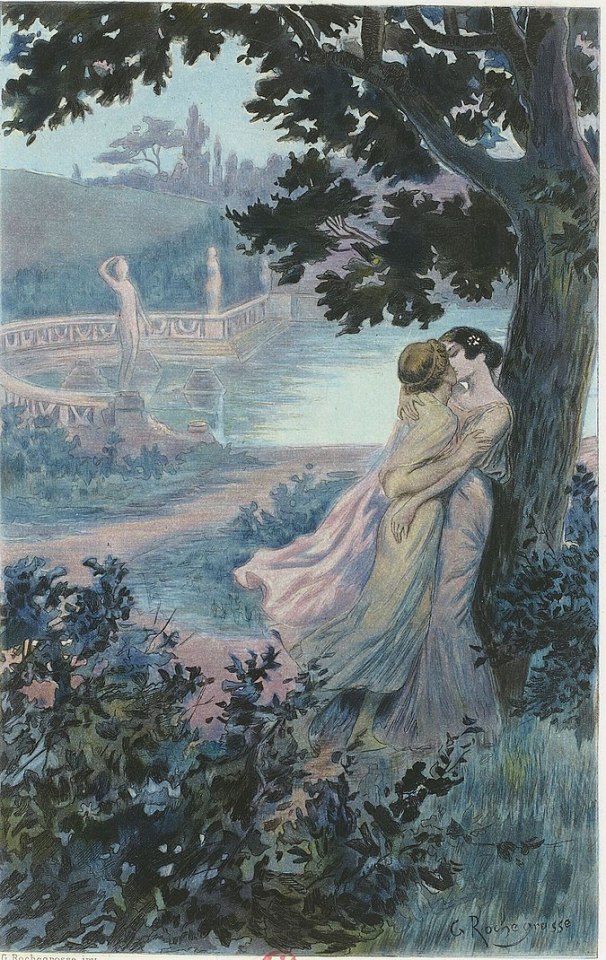
Two women kissing in nature, by Georges Rochegrosse (1859-1938).
This is such a sweet picture. I’ve seen it pop up a few times on Tumblr.
And now I am going to ruin it. But then I’m going to try and unruin it! However, if you just want two girls kissing in nature then scroll on by and vote in some polls. It’s all good.
So this is an illustration from 1903 French novelette Le Poison des Pierreries (The Poisoned Stones) The two characters kissing are the Princess Alilat (the tall brunette) and the Prince Sparyanthis (the blond). Sparyanthis is eighteen years old and we weren’t yet at the point where we required super-buffness to indicate masculinity, so the artist depicts him as a pretty youth. But don’t stop reading! Because 1.) this is a tale of eroticism, revenge, obsession, and treacherous murder by sorcery, and who doesn’t love all that? and 2.) there is nothing straight about this couple or this novel.
Also, 3.) it’s pretty sexy. So, you know. Be aware fellow asexuals.
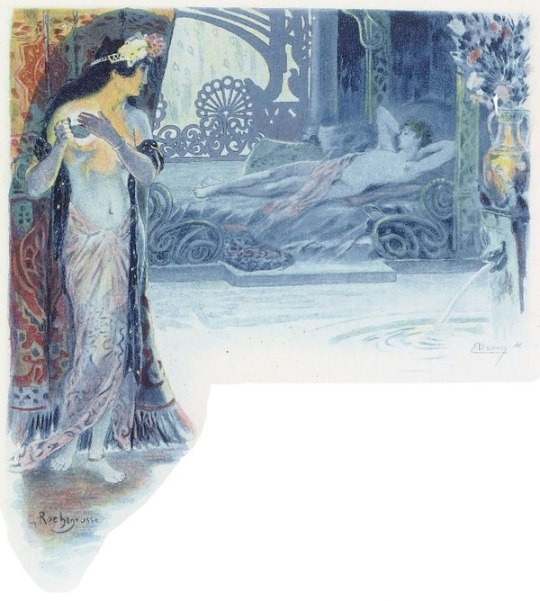
Le Poison des Pierreries was written by the author and essayist Camille Mauclair for his friend the Orientalist Georges Rochegrosse to illustrate. Orientalism was very pretty but very, very problematic and if you don’t know why you can easily find out by doing a search.
(BTW I am not an expert on textual analysis or art history, or queer and gender theory, and know almost nothing about the French language — when I get stuff wrong feel free to let me know! I’m sure at the very least there are lots of classical allusions I’m missing.)
Also: there’s some implied lack of consent in this story.
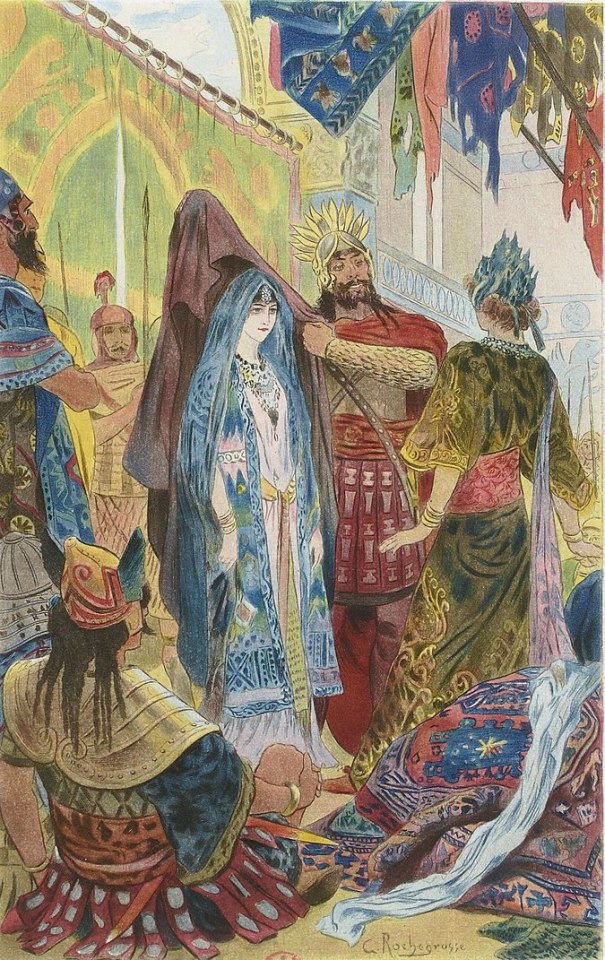
The novelette tells of the distant city of Etesia. It is ruled by two brothers, the doughty warrior Cimmérion and the beautiful, decadent Sparyanthis. They are really really fond of each other. But in a way that wasn’t a big deal in 1903.
Cimmérion arrives home from war with the beautiful princess Alilat whom he has forced into marriage. Alilat is now the last of her house, thanks to Cimmérion, because he’s slaughtered everyone she ever knew, and she has opinions about this. Despite Sparyanthis’ best intentions, Alilat beguiles him, and they begin having an affair while Cimmérion is away hunting each day. ‘Two women kissing in nature’ is the moment when Sparyanthis finally gives in to his desire for Alilat.
But Alilat is (understandably) after revenge for herself and her people, and she uses her sorceries to bring a strange malady upon Cimmérion that robs him of his strength. At the same time she relishes the agonies of guilt Sparyanthis feels over his ongoing betrayal of his beloved brother.
Eventually everyone dies!
But until that happens there is a lot of queer sex going on.
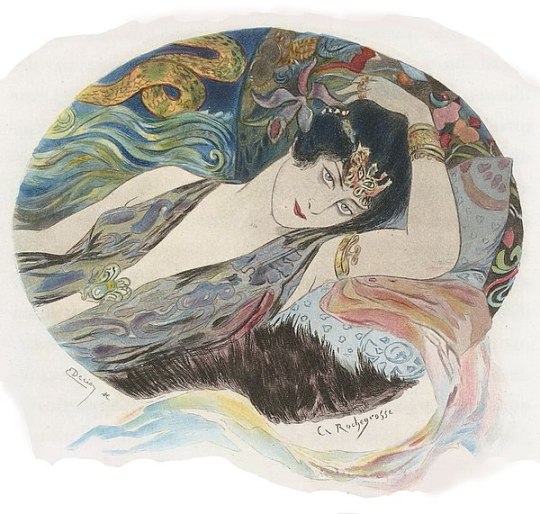
The Queerness
So we can try and read this story as someone from 1903, or we can read it as someone from today. In 1903 it’s a story of masculinity as a vital, conquering, barbarous force versus femininity as a languid, yielding, civilising… perhaps too civilising… influence. A healthy nation was thought to be warlike and ever-expanding. Old civilizations — like the ancient nations of the East — were regarded as rich but dwindling due to becoming too decadent; their sexual mores (which the West took a not at all creepy interest in; c.f. Richard Burton) were held to be intriguing but Not The Done Thing. A proper western couple — one (1) man + one (1) woman, married — had quick, penetrative sex and then went to sleep or something idk. This is how Cimmérion takes Alilat, and she loathes him for it (there’s a line about her ‘being thrown down upon the couch of the conqueror’ and having to endure his caresses). Real men are too busy hunting or making war or running kingdoms to bother much about girls.

But Sparyanthis is quite a different sort of person from his dull brother. He wanders around the palace in women’s clothes having sex with whoever he finds; the explicit incidents are with women, but there are plenty of young men in the illustrations. And everyone is down with it because the Etesians are known for two things: war and having A LOT of sex, never mind with who (at one point Spary can seek out Aliat at night because all the servants are busy making out with all the soldiers in alcoves).
Both in words and illustrations Mauclair and Rochegrosse suggest Sparyanthis is a young woman. He is ‘more beautiful that all the maidens of that country’. He is frequently described as wearing women’s robes, or of being naked except for his jewellery. He is languid and wanton (not vigorous and virile like Cimmérion), with golden tresses and soft, white limbs. There are suggestions that he is sometimes rouged or kohl-eyed, but I don’t trust my translation enough to say for sure. He lays around on couches and beds a lot, and delves into non-manly stuff like magic and secret knowledge. There’s much made of how devoted to each other the two brothers are because of their differences. Soft, white Sparyanthis idolises tanned, brawny, bearded Cimmérion, and Cimmérion ‘adores Sparyanthis’ beautiful body’.
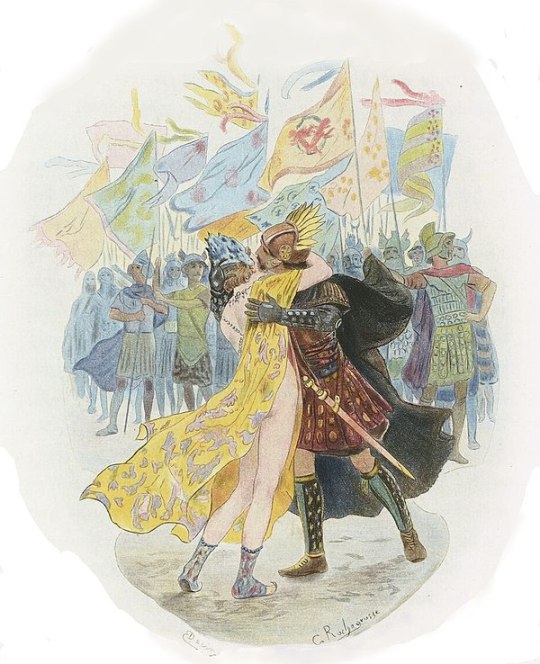
Alilat, meanwhile, is not an Etesian and is accustomed to wearing sombre modest clothing (there is a scene where Sparyanthis invites her to one of his afternoon gambols, and when everyone strips off and starts making out Alilat remains in her black robes and pointedly focuses only on her host, Sparyanthis, and he wonders what’s going on). But once she seduces Sparyanthis, she starts playing with gender too: she frequently meets him dressed in masculine clothes, while he is still in his woman’s garments. She is a vital force, determined as she is to achieve her revenge, and this is juxtaposed with Sparyanthis’ languorous attitude. She is compared to a hunter, and him to the quarry.

Alilat explicitly cannot stand the touch of a man, so she's having an affair with the beautiful, voluptuous Sparyanthis... because neither her nor the story considers him a man.
She intends to destroy both Cimmérion and the city of Etesia, and she takes a devilish glee in how tortured with guilt Sparyanthis is, but she does seem to be as sexually obsessed with him as he is with her. And there are moments of maternal kindness too, where she fondly treats Spary like a younger sister.
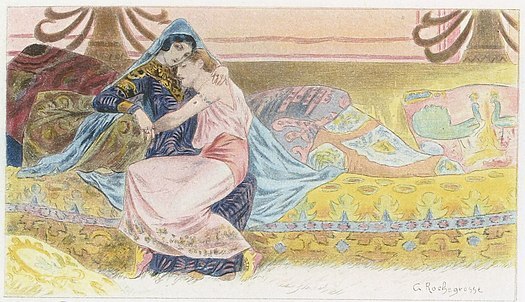
So while in 1903 it’s a story of what city-destroying calamities happen when men and women don’t follow their natures or whatever, today it reads like messed up queer people having a lot of queer sex. And I think it’s definitely much more fun to read it that way.
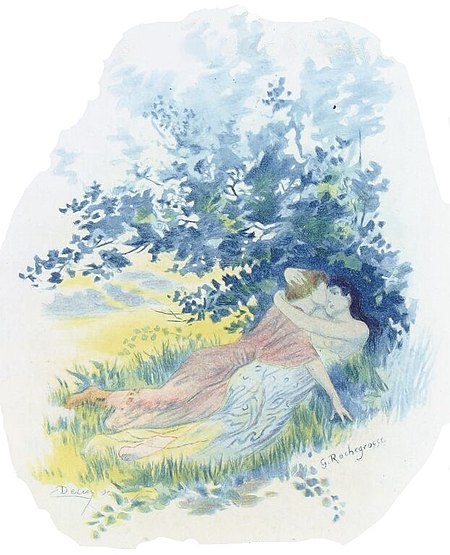
The Sex
So I am asexual and modern sex stuff doesn’t really do much for me. But, tell you what, 1903 veiled door sex knows what it’s about.
Everyone is having great sex here, and it’s implied that because of all this sensuality the kingdom is doomed to fall: the ‘warm voluptuousness’ is ‘softening the men’. You just can’t run a country while everyone’s fucking all the time, and Mauclair is here to tell you all about how bad an idea it is.
No sex is ever described (though it’s taking place in the background of at least one illustration), so the excitement is all in the set-up: Alilat abducts and fucks Sparyanthis while dressed as one of his own archers (“and seized him with the audacity of a soldier taking a weak, conquered Syrian”). A bearded magician approaches Sparyanthis while he is studying the stars in his chambers and traces on the ground with a wand the symbol for an astrological union, and then the 'magician' opens her robe enough to reveal her breasts and they have sex with Alilat still wearing her false beard. I mean
They met in secret caves and rut like beasts, howling, then sit in the throne room in their official robes and give each other secret looks (which, to be fair, is kind of like every new love affair).
Sadly there are no illustrations of any of this! I guess Rochegrosse just wanted to draw beautiful youths embracing and had no time for Mauclair's gender-switching antics, and I think that's a shame.
Anyway, because Cimmérion has laid hands upon Alilat without her permission she has come up with a very particular murder scheme. She tells Sparyanthis that Cimmérion prefers to take her ‘naked save all her jewellery’ and so she enchants her jewellery to burn away his vitality while it caresses his bare skin — the Poisoned Stones of the story’s title. The very act of sex brings about the stoic Cimmérion's murder.
Everyone in Etesia is making out with everyone else, and Cimmérion’s and Alilat’s marriage seems to be the only expected exception to all this polyamoury or so you would think. But then comes the kicker at the end: as Cimmérion lies on his death bed he tells Sparyanthis and Alilat that he knew all about their secret love the whole time and he was totally okay with it: they should carry on with his blessing. Sparyanthis is not okay about that. But too late, bud.
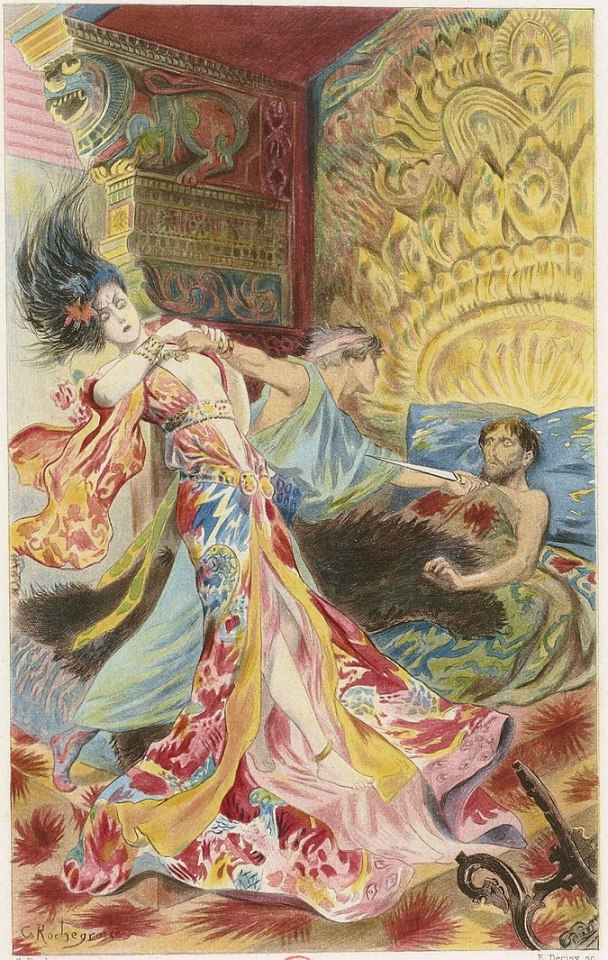

Anyway, not two women kissing in nature, but — I think — two genderqueer people kissing in nature. Read it for yourself! It’s really short!

(Okay, so this is too long already, but Alilat is just so cool. She sends dreams to Spary and begins seducing him before they've even met.
There’s this whole bit where she summons up a spirit of fire from the underworld to infuse her jewellery with wicked magics, and Sparyanthis is like “Do we need to use sorcery? Can’t we just stab him?” and Alilat says “Don’t be such a nerd, Sparyanthis, I wanna do it with evil sex.”
And there’s also another part where she’s wondering about how it will all turn out once Cimmérion is dead, and she’s thinking that maybe she’ll usurp the throne, but then again maybe she’ll just destroy the kingdom and then ride out across the desert as it falls, laughing, and then she’ll go to the mountains and establish her own country of sorceresses and she will be their queen.
And hey, maybe the Alilat who ‘died’ was only a simulacrum and the real Alilat did just that. I hope so, people should just leave a girl alone.)
#Le Poison des Pierreries#French Novel (1903)#Two women kissing in nature#by Georges Rochegrosse (1859-1938)#Playing with gender#Genderqueer#orientalism#A lot of sex#Like a LOT#Sorcery
123 notes
·
View notes
Text
Goddess Al'lat
Arabian Goddess
Often a chief goddess in various ancient Arabian locations.

*I could not get her Safaitic name inscription for the table
—How to use the Internet Archive Link
🔵 Information
From Chapter 4 The Goddess of Pre-Islamic Arabia by Zofia A Brzozowska in Byzantium and the Arabs. The Encounter of civilizations (Academia Link):
“Some scholars are of the opinion that the three goddesses: Al’lāt, Al’Uzzā, and Manāt whose cult reached back to ancient times, occupied a particularly prominent place in the pre-Muslim pantheon.” Page 55.
“The name of the first of these goddesses appears already in the works by Herodotus, written in the fifth century BC. In describing religious beliefs of the Persians, the father of history points to the Assyrians and the Arabs as those from who the Persians adopted the cult of Aphrodite Urania. enumerating various names given to the goddess by different ethnic groups, the Greek historian says that the Arabs called her Alilat.” Page 55
“According to many scholars Arab religious cults described by Herodotus and his continuators were particularly popular with the Arab tribes inhabiting Nabatea— the State that existed from the fourth century BC to the first century CE. Archaeological excavations in this area prove that Al’lāt and Al’Uzzā— along with the God Dūshara, topped the Nabatean pantheon.” Page 56
“The cult of the goddess did not ceased to exist when Nabatea fell under Roman rule in 106 [CE], but by assimilating elements typical to the ancient religion it acquired a new dimension. Al’lāt began to be equated with Athena as is evidenced by the basalt stele representing the Goddess […] dated to the second century CE the stele shows the goddess standing with A spear in the right hand and a small shield in the left. Attired in Greek robes the goddess is wearing a helmet and breast plate.” Page 58
“To the discussion of the main goddess of Nabatea one should add a few remarks on the religious system that existed in Palmyra. archaeological excavation’s conducted by Polish scholars Leads to the conclusion that Al’lāt was one of the most important deities in the Palmyran pantheon. her name appears in a great number of inscriptions discovered in the city. A temple dedicated to this goddess was erected in the first century BC. it was rebuilt several times adjusting its architectural design to the change in the development of the urban area. Michal Gawlikowski is of the opinion that the temple survived Roman interventions which took place in the third century CE and it was not until the fourth century CE that it finally fell into ruin.” Page 62-63
From The Palmyrenes of Dura-Europos: A Study of Religious Interaction in Roman Syria By Lucinda Dirven page 78-79 (Internet Archive Link):
“The nomadic origin of members of the Bene Ma’zin [tribe] is apparent from the predominantly Arab character of the deities venerated in both sanctuaries the goddess Allat is the deity most frequently attested in Safaitic inscriptions throughout Arabia until the advent of Islam. Her name derives from Arabic al-‘ilâhat meaning ‘the goddess’ a clear indication of her importance. The goddess is first mentioned by Herodotus in the fifth century BCE. according to the Greek historian the desert people of the Sinai worshipped two deities: Orotalt (i.e Arabic Rada, Palmyrene Arsu) and Alillat, by whom they took oaths”
🔵 Inscriptions to Al'lat
From The Religion and Rituals of the Nomads of Pre-Islamic Arabia: A Reconstruction Based on the Safaitic Inscriptions by Ahmad Al-Jallad Chapter 3 (Academia Link)
*apologies for no alt text in some of these, the notation causes gibberish when I use the copy/paste technology



Page 94:

🔵 Iconography
Relief from Temple of Ba'alshmanin, Palmyra. 1st cent A.D. Goddess Allat with Palm + Lion. Mains Mus, Germany. XII.5.20 (Link)

Lion of Al'lat

From Lions of Al'lat by Michal Gawlikowski (Link 1) (Link 2)
The sculpture represents a huge lion in frontal view and was certainly incorporated into the wall of the sanctuary. There are no clues as to its exact location, but it would be sensible to suppose that the animal served as a guardian of the gate. As all recovered fragments fit into the restored monument, there is no reason to believe that a symmetrical beast accompanied this one at the other side of the entrance.
The figure of the lion is 3,46 m high from tip to toe and 1,94 m wide at the head. The half-opened mouth shows menacing fangs. The luxuri ous mane covers entirely the breast, leaving only the front legs apparent. Between these, an antelope is crouching, putting confidently one front leg on the predator’s claws. The sculptor rendered precisely the features of oryx leucoryx (Pallas 1777), a large animal of white complexion and long straight horns, once frequent in Syrian and Arabian deserts. Extinct in Syria for a while, the species has been lately reintroduced in the Talil reserve not far from Palmyra, where a herd of some thirty animals roam now a fenced stretch of the desert. Though maybe deriving from a hunting motive, the composition clearly intends to convey the impression of an idyllic friendship between the predator and its usual prey. The oryx is being protected between the formidable paws and shows no signs of alarm, while the lion seems to deter the beholder from harming its charge. This impression is confirmed by a short text inscribed on the left paw of the lion. It runs: “May Allat bless whoever does not spill blood on the temenos.” […] In front of the primitive chapel there stood an altar, preserved in the same place inside the later cella. Only the lower part of it subsists today, but the fact that it remained in the 2nd-century temple is proof enough that no animal sacrifice was performed on it. The altar, when complete, had to be rather high and would be intended just for frankincense offering, as most Palmyrene altars were.

The statue was put on display in 2005 in Palmyra Syria, destroyed in 2015 by Daesh, but moved to Damascus and restored again in 2017:

Amulet with Al'lat (Link)

🔵 More Reading
Representing and Naming the Gods. Iconography and Nomenclature of the Goddess Allat in Palmyra and Hatra by Lucinda Dirven | Discussion of Al'lat’s cult images and identifications with Greek deities LINK
ALLĀT AND THE DESERT “KULTLANDSCHAFT” OF ALLĀT IN THE EAST by Aleksandra Kubiak-Schneider | “…offers a study not through the “Arabic”, ethnic, approach, but through the topography of the sacred places dedicated to the goddess. The paper focuses on the emplacement of the temples of Allāt” LINK
#polytheism#paganism#landof2rivers#arabian#arabian polytheism#al'lat#allat#goddess#god#deity resource#queue
6 notes
·
View notes
Text
"What were Herodotus’ thoughts on religion? Is there any sort of worship of him as a prominent spiritual figure?
Answer by Anthony Ellis
Herodotus was clearly fascinated by the discrepancies in how different people imagined and worshipped the gods. But he didn’t think of the world as divided into a series of separate and distinct ‘religions’. Instead, he took it for granted that, by and large, most societies worship the same gods but simply imagine them differently: each group of people has its own names for the gods, worships them using its own rites, depicts them differently in its icons and sculptures, and tells different stories about their birth, powers, and functions. So, in Herodotus’ view, it’s not the case that you have your gods and we have ours. Rather the god whom we (Greeks) know as ‘Aphrodite’ is also worshipped by the Arabians, who call her ‘Alilat’, and by the Assyrians, who call her ‘Mylitta’, and by the Persians, who call her ‘Mitra’ (see his comments at 1.131.3). This practice of theological ‘translation’, which equated the pantheons of different peoples, was not Herodotus’ own invention – it was part of a long tradition in the ancient Mediterranean and Near East.
If this tolerant attitude to what we would think of as ‘foreign religions’ seems unfamiliar, that’s in large part because the ‘Abrahamic faiths’ and the cultures which evolved out of them have historically understood religious difference in other ways. In the early Christian centuries, for instance, another model prevailed: that of ‘heresy’. Christian heresiologists contended that a primal ‘orthodoxy’ had always been known to God’s chosen people, but that it had been continuously assailed by ‘heresies’ which led the faithful into idolatry, producing a vast and sinister diversity of religious practice. Only over the last few centuries has it become common to think of humanity as being divided into a series of ‘world religions’ which exist on a level footing with one another and worship different and historically unrelated deities. Both of these approaches would have left Herodotus and his contemporaries scratching their heads.
For anyone wondering how so many different peoples came to worship the same gods, Herodotus has an explanation: knowledge of individual gods spread gradually from one people to another through mutual contact, typically flowing from older societies (like the Egyptians) to younger ones (like the Greeks; for an example, see 2.145-6). The first inhabitants of Greece, he says, thought of the gods as an undifferentiated group (known simply as ‘the gods’); but later they learned the Egyptian names for the gods and, once an oracle gave them permission, they began to use them. Remarkably, Herodotus claims that most of what makes Greek religion distinctive – including the gods’ cultic epithets, powers, and the stories of their births, marriages, and conflicts – was first formulated long after this by the great poets Hesiod and Homer, whom Herodotus dates at 400 years before his own day (2.50-3). Although Herodotus never makes explicit global criticisms of how the ‘Greeks’ imagine the gods, he clearly thought that some of what these poets said was untrue – for instance, that gods took mortal lovers and had semi-divine children (for his discussion of confused or foolish Greek ideas about the gods see, for instance, 2.43-5). Like many other Ionian and Athenian intellectuals, he probably doubted that the gods resemble humans in the way that traditional Greek epics and cult-depictions implied.
All this might suggest that Herodotus had a critical – perhaps even sceptical – view of religion. But most of this is based on what Herodotus writes in his more ‘anthropological’ moments. Herodotus’ Enquiries are extremely diverse and, when he embarks on more literary narratives, he writes about the gods in ways which would have been more familiar to Greek readers. Much as in Greek tragedy, his stories give prominence to gods, oracles, fate, prodigies, and other forms of divine intervention. He makes it clear that human life is wholly dependent on the good will of deities who are strict in their punishment of injustice – but who do not rule the world in a manner conducive to human flourishing. In fact, some of the work’s most prominent descriptions of the gods present them as hostile to humans, so jealous that they constantly disrupt mortal life and ensure that no human enjoys unlimited success, happiness, reputation, youth, or health (for example, see chapters 1.32-3, 3.40, 7.10ε, and 7.46). These passages have, quite rightly, led many to think that Herodotus had deep religious convictions.
The second part of this question took me by surprise, since I’d never thought of Herodotus being viewed as a religious or spiritual figure. In antiquity he had a very chequered reputation: although he was respected by many – dubbed the ‘father of history’ by Cicero and others – he was also criticized as a liar who intentionally spread mistruths and slander about the most glorious episodes of Greek history. On the rare occasions that his religious views came under scrutiny in antiquity and the Middle Ages, his descriptions of the gods as jealous and hostile towards humanity tended to be dismissed as blasphemy, by pagan philosophers and Christians alike (I discussed some examples here). Herodotus certainly achieved cult status among some historians, but few have claimed him as a source of spiritual guidance and none, to my knowledge, have actually worshipped him in a religious sense.
Ironically, the closest example might be Protestant humanism. As I’ve discussed elsewhere, the Lutheran reformer Philipp Melanchthon (1497-1560) claimed that Herodotus’ writing was part of God’s plan to provide humans with a continual record of world history. Melanchthon and his students argued that God inspired Herodotus to start his history at the point where the Old Testament finished, and declared that his writings provided a perfect illustration of the Ten Commandments. This isn’t actually so far from viewing Herodotus – or his writing – as a religious authority of some sort. But that has to be put in context. Melanchthon and others looked for overtly Christian interpretations of almost all of the ancient Greek ‘classics’, and their interest in what Herodotus thought about the gods extended only to cherry-picking ideas which supported their own opinions and ignoring the rest. Of course, they treated ancient Hebrew literature of the Bible in precisely the same way. So perhaps we could say that here Herodotus did come close to becoming some kind of ‘religious’ or ‘spiritual’ authority – though even these Protestant humanists would certainly have insisted that he was in a completely different class to Christian Scripture.
Further Reading:
Assmann, A. 1996. ‘Translating gods: Religion as a Factor of Cultural (Un)Translatability’, in S. Budick and W. Iser (eds), The Translatability of Cultures. Figurations of the Space Between. Stanford, 25-36.
Burkert, W. 1990. ‘Herodot als Historiker fremder Religionen’, in G. Nenci(ed.), Hérodote et les peuples non-grecs (Entretiens Hardt 35., Geneva, 1-32 (repr. in his Kleine Schriften VII: Tragica et Historica (ed. W. Rösler). Göttingen,140–16.
Ellis, B. A. 2015. ‘Herodotus magister vitae: or Herodotus and God in the Protestant Reformation’, in id. (ed.) God in History: Reading and Rewriting Herodotean Theology from Plutarch to the Renaissance, Histos Supplement 4. Newcastle upon Tyne, 171–245.
Ellis, B. A. 2021. ‘Religion, Herodotus’ views on’, in C. Baron (ed.) The Herodotus Encyclopedia (Malden, MA), 1228–1233.
von Lieven, A. 2013. ‘Translating Gods, Interpreting Gods. On the Mechanisms behind the Interpretatio Graeca of Egyptian Gods’, in I. Rutherford (ed.) Greco-Egyptian Interactions. Literature, Translation and Culture, 500 BCE – 300 CE. Oxford, 61-82.
Harrison, T. 2000. Divinity and History. The Religion of Herodotus. Oxford.
Scullion, S. 2006. ‘Herodotus and Greek Religion’, in C. Dewald and J. Marincola (eds), The Cambridge Companion to Herodotus. Cambridge, 192-208.
Schwab, A. 2020. Fremde Religionen in Herodots “Historien”. Religiöse Mehrdimensionalität bei Persern und Ägyptern. Stuttgart."
From the site of Herodotus Helpline.

Anthony Ellis, Institut für Klassische Philologie, University of Bern
6 notes
·
View notes
Text
Tips for endgame skills in SMTIVA
A quick info compilation for newbies and long-time fans alike. Strategies and skill sets can vary between bosses, so consider this just an overview.

Before deciding on your team¹:
1- Consider the stats points. Which stat is the strongest? Ex: if Matador is the strongest in St/Ag/Lu, he stands with advantage on accuracy and criticals, hence multi-hit Phys attacks. 2- Consider the affinities. Which affinity is the highest? Ex: if Izanami has the most points towards Elec and Healing, her set should focus on Elec and Healing skills. Alilat is a HP/MP tank with +3 on Support, so she fits staying behind to provide for others instead of being in the front line. 3- Decide the roles. Who's an Attacker? Healer? Support? A mix of two roles can work as well. Ex: Nanashi will be the main Magic attacker. Matador will be the main Phys attacker. Izanami will be Magic attacker and Healer. Alilat will be Support and Healer. => In this example we have 2 party members attacking nonstop, 1 keeping their defenses in check nonstop and 1 sharing both tasks.
There are more ways to spread the tasks but what's important is that 1. All three roles (attack/heal/support) are being fulfilled. 2. Attack is in priority. ¹(of course you can add more points to stats and affinities through DLC and drops from Fiend battles but -still- you won't be able to modify too much or alter altogether the original config of a demon: the demon must have at least +1 in the affinity of choice and Healing/Support only go up to +5 while the rest goes to +9)
Now that you put these in mind... 1) ATTACK The press turn system encourages you to get criticals so you can have extra turns for healing and buff/debuffing.
1.1 Enhancing -> The enhancing skill you pick for physical attackers will depend on your strategy. a) Critical Eye (guarantees critical + extra turn + sometimes smirk) is considered the safest option. b) Charge hits 2.5x more but doesn't guarantee other benefits so add Bloody Glee (increases crits) + Draconic Reaction (greatly increases hit/evade) alongside it to increase your chances. If you can only choose one option, pick Draconic Reaction. Bloody Glee and Draconic Reaction are important in Twisted Tokyo even with maxed Agility/Luck. -> For magic users: pick Concentrate (2.5x as well) instead of Smile Charge, as you won't have use for the latter once you have Pierce. Magic can crit in SMTIVA in contrast to SMTIV.
1.2 Most powerful Phys skills -> Akasha Arts (Severe hit, Pierce on Smirk, base of 350) > Gungnir (Severe hit, Pierce, base of 310 max, Odin-only). -> Andalusia (4-12 Heavy hits, Matador-only) > Blade of Terror (1-5 Heavy hits, Pierce, Panic, Red Rider-only). -> Hell Thrust (2-4 Heavy hits + Rakunda on Smirk) *Special Notes
Multi-enemy skills have the most damage potential but you can miss turns if even one of the attacks miss, so consider whether a demon has the appropriate build to handle risky moves.
Pleroma (1.25x) and High Pleroma (1.5x) skills stack. Having both deals 87.5% more damage.
How much affinity a demon has for a type of skill plays a more important role in how effective it's gonna be than stat points.

2) DEFENSE
2.1 Against Elements
Pierce goes through both Drain and Repel in SMTIVA, in contrast to SMTIV. Keep this in mind since endgame bosses have Pierce to their attacks (Physical attacks tends to be the exception).
Dark weakness is the one you have to worry about the least. To the point you actually shouldn't even bother wasting a skill slot to cover it. The vast majority of the endgame bosses don't use Dark skills at all whatsoever.
2.2 Against Ailments Charm is the most dangerous ailment as it can make you heal the enemy so put priority on avoiding it. -> Demons that are nullified against ailments like Satan or Alilat are good recommendations. -> For those that aren't, Null Mind (sleep/panic/charm/mute) > Null Nerve (poison/sick/daze/bind) > Hellish Mask (only adds resistances). -> Salvation isn't reliable as it's not only an expensive skill but also requires smirking to heal ailments.
2.3 Healing yourself -> If you don't mind farming for items, Healing Knowhow can save A LOT of space for other skills (aside healing it also covers some support such as Dekunda/Dekaja stones, Summon stones, Atack/Magic mirrors etc). You could spread the tasks and include it even in demons not designed for Support. -> However powerful items also tend to have limited stock so having a mix of your own magic + items instead of entirely relying on one option goes better. -> Energy Drain/Soul Drain can be useful to replenish MP (specially paired up with Almighty affinity + Magic build) but if you have the special items from the Saint German Shop like the Complete Restoration Gem you might consider saving up space for another skill. You can acquire the jewels necessary to buy these items through those purple "flowers" Navarre can destroy or farming in the DLC. *Special Notes
Best Support Duo: Krishna (debuff attack -2 defense -2, cheaper Luster Candy) & Cleopatra (debuff defense -3).
Imposing Stance (removes 1 press turn from foe) prevents enemies from comboing (ex: debuff+smirk+attack) and killing your team.
Doping (+30% max HP for party members) is usually just used once so it shouldn't be a problem to put it in a non-Support demon so you can divide the tasks more evenly.
Invitation (Revives, fully heals, and summons a demon from stock) and Healing Knowhow preferrably in the HP tank.
4 notes
·
View notes
Text
I've seen this post floating around for years and felt fairly sure it was yet another misidentified depiction of a heterosexual couple, but not being familiar with the source material, didn't have anything concrete to prove that with. My familiarity with ancient greek fashion and Edwardian illustration left me in little doubt it was meant to show a man and woman-- the illustration is in greco-roman fantasy style and the shorter tunic, short curled hair, and apparent Adam's apple of the figure of the left would seem to indicate the character as male. It's a similar look to what the Charioteer of Delphi had going on


(or compare him to figures in Wyeth and Maxfield Parrish for instance) meanwhile the longer robe, longer hair, and more Edwardian styling of the figure on the right would probably indicate female. I did some looking into the case and dead-ended at the title and author of the book, finding some page scans but in French too dense for me to penetrate.
Checking back in recently however I found the book text had been digitized and was able to be translated into working English.
Here's the book info listed in French Wikimedia relating to the illustration in question, from which I was able to access the digital text:


The scene listed ("ce fut dans un chaud crepuscule") begins roughly here in English:

Reading on provides the background for the illustrated scene as well as confirming my original hunch:
These are not, and never have been lesbian lovers, this illustration is of a tryst between a fictional heterosexual couple.
The black haired woman is Alilat, who is apparently seducing Prince Sparyanthis, her brunette companion, as part of an elaborate revenge plot against his brother.
Here is the depicted scene in its entirety, with illustration in place


There's also another illustration of them together a few pages later, showing the same character design and costume, in case further evidence was needed

These illustrations/characters represent a heterosexual couple and are not lesbians. Any identification of them as such is erroneous. Thank you.

‘Two Women Kissing in Nature,’ an illustration from ‘Le Poison Des Pierreries’ by Georges-Antoine Rochegrosse, 1903
#felt like making this a reblog of the og post was the best idea#but if op prefers I'll make my own new post instead#boy this felt good to finally share!#vintage gay: yea or nay
5K notes
·
View notes
Text

Deusa da guerra, da paz, do combate e da prosperidade, Al-Lat com um ramo de palmeira e um leão do templo Ba'alshamîn em Palmyra, século I EC. Damasco, S��ria. Deusa árabe pré-islâmica - Al-Lat (árabe: اللات, romanizado: Al-Lāt, pronuncia-se [alːaːt]), também conhecida como Allat, Allatu e Alilat, é uma Deusa árabe pré-islâmica adorada sob várias associações em toda a península, inclusive em Meca, onde era adorada juntamente com Manat e al-'Uzza como uma das filhas de Allah. A palavra Allat ou Elat foi usada para se referir a várias Deusas no antigo Sudoeste Asiático, incluindo a Deusa Asherah-Athirat. Al-Lat é atestada em inscrições do sul da Arábia como Lat e Latan, mas tinha mais destaque no norte da Arábia e no Hejaz, e seu culto chegava até a Síria. Os escritores da escrita safaítica frequentemente invocavam Al-Lat em suas inscrições. Ela também era adorada pelos nabateus e estava associada a al-'Uzza. A presença de seu culto foi atestada em Palmyra e Hatra. Sob influência greco-romana, sua iconografia começou a mostrar os atributos de Atena, a Deusa grega da guerra, bem como de sua equivalente romana Minerva. De acordo com fontes islâmicas, o povo de Banu Thaqif em Ta'if a reverenciava especialmente. Na tradição islâmica, sua adoração terminou quando seu templo em Ta'if foi demolido por ordem de Mohammed.
Saiba mais na live Sabedoria, Shechinah e Allat: metamorfoses divinas em meu canal do Youtube (Angela Natel) - https://www.youtube.com/watch?v=bvF_kuhUUos&t=4056s
0 notes
Text
Alilat is a lot more bearable to fight when you know what you're doing. Unfortunately, she does not give much loot
Moonie is not amused by this development
0 notes
Photo










smt v demons (part 6)
#long post#shin megami tensei v#gamingedit#vgedit#eligor#basilisk#pixie#melchizedek#cait sith#alilat#lachesis#power#asura#yamata no orochi
226 notes
·
View notes
Text

Quick Alilat doodle! ❤️
#art#digital art#my art#idrawstuff#sketch#quick doodle#Alilat#smt#megaten#shin megami tensei#persona
17 notes
·
View notes
Photo

Allat (or Alilat), a pre-Islamic Arabic goddess of war.
8 notes
·
View notes
Quote
but they [the Persians] have learnt also to sacrifice to Aphrodite Urania, having learnt it both from the Assyrians and the Arabians; and the Assyrians call Aphrodite Mylitta, the Arabians Alitta, and the Persians Mitra
Herodotus, the Histories
Likely this does not refer to Mithra, who was a male god, but Anahita, a Zoroastrian goddess associated with water, healing, and Venus as the Morning Star.
3 notes
·
View notes
Text
I was reading this translation of an old Kaneko interview by dijeh and something stood out to me. When Kaneko is asked about his use of bold colors for his demon designs, he has this to say:
Strictly speaking about colour, the times of legends might as well have been very colourful in reality. The Buddhist statues and wall paintings we see nowadays have chipped and faded colours, but I’m sure their original colours used to be very rich. I am bringing the concepts of those times into the present...
My mind was immediately cast back to Doi's Zeus, which incorporates the typical white marble statue look we associate with ancient Greek art in its design. I thought it was interesting how Kaneko considered how the art he based his designs on would have looked like during the time it was made, whereas Doi went for the white marble look even though we now know that those statues were originally painted with bright, bold colors, which were only lost due to time (or worse, scrubbed off by restorers). I find this contrast interesting and perhaps even telling of the way both artists approach demon design for the series.
______________________
Yeah! And come to think of it, only a handful of Kaneko designs retain some kind of statue form. Arahabaki (who moves like a robot in 3D), SMT2 Cherub (literally a statue), Alilat (designed to be a floating obelisk) and...


But Gozu-Tennoh is also literally a statue and Maria form 2 is a figurative representation of an artificial intelligence and has the better first form that has seemingly been forgotten. The only one out of these five that completely lacks any color is the SMT2 Cherub.

And, again, they're just static guardians, not the organic/dynamic representations of deities that comprise the majority of Kaneko's designs. All this said, I think Doi's Zeus needs a lot more than just bold colors to be an effective design.
17 notes
·
View notes
Photo


📷: Al-Lat with a palm branch and lion from the Ba‘alshamîn temple in Palmyra, first century AD. Damascus, Syria
This is not The Asherah, it is Allah’s second birth offspring. Allah and Asherah’s daughter is the 2nd/second in the family with 4 offspring. She is their only girl like me and several other deities.
Al-Lat (Arabic: اللات, romanized: Al-Lāt, pronounced [alːaːt]), also spelled Allat, Allatu and Alilat, is a pre-Islamic Arabian goddess worshipped under various associations throughout the entire Arabian Peninsula, including Mecca where she was worshipped alongside Manat and al-'Uzza as one of the daughters of Allah. The word Allat or Elat has been used to refer to various goddesses in the ancient Near East, including the goddess Asherah-Athirat.
Al-Lat is attested in south Arabian inscriptions as Lat and Latan, but she had more prominence in north Arabia and the Hejaz, and her cult reached as far as Syria.[3] The writers of the Safaitic script frequently invoked al-Lat in their inscriptions. She was also worshipped by the Nabataeans and was associated with al-'Uzza. The presence of her cult was attested in both Palmyra and Hatra. Under Greco-Roman influence, her iconography began to show the attributes of Athena, the Greek goddess of war, as well as her Roman equivalent Minerva.
According to Islamic sources, the tribe of Banu Thaqif in Ta'if especially held reverence to her. In Islamic tradition, her worship ended when her temple in Ta'if was demolished on the orders of Muhammad.[4]
➡️ Major cult center:
Palmyra, Iram,[1]Ta'if (according to Islamic sources)
➡️ Symbol:
Lion, gazelle, crescent, cubic rock
➡️ Region:
Arabia
Healey 2001, p. 111. Healey, John F. (2001), The Religion of the Nabataeans: A Conspectus., Brill, ISBN 978-90-04-10754-0
^ Jump up to:a b Butcher 2003, p. 309. Butcher, Kevin (2003), Roman Syria and the Near East, Getty Publications, ISBN 978-0-89236-715-3
^ Jump up to:a b c d e f g h Healey 2001, p. 114. Healey, John F. (2001), The Religion of the Nabataeans: A Conspectus., Brill, ISBN 978-90-04-10754-0
^ "Tafsir Ibn Kathir - 53:19 - english". quran.com. Retrieved 2021-05-21.
13 notes
·
View notes
Text
About SMT Nocturne’s Italian localization
(This post was initially meant to be a submission for @eirikrjs, then I realized that making my own post would give me less of an headache with the added pictures, so here it is. This might very well just be my first and last post on Tumblr)
Yesterday some SMT III previews dropped, and since the only thing I care about regarding that game is its localization, mostly the Italian one, I immediately looked at that. There's some interesting stuff, I swear.
First of all, about MegaTen and Italian: if we aren't counting Catherine, Persona 5 Royal was the first game in the series that got translated. French and Germans got "Lucifer's Call" (which afaik didn't have a great translation either), but we weren't so lucky, so the only translations we got are P5R and P5S'. Both of them are definitely based on the English script, even if I wouldn't rule out the chance they actually checked the Japanese script for some minor stuff.
About P5R's translation... it's mostly fine. It's got some typos and whatnot, but for a game that massive it's nothing unusual. As for the "mythological department", it doesn't look like they did much research on their own. The two most interesting things are Alilat which got changed to Allat (and the translated description has an added "also known as Alilat", which is nice) and Thunderbird which got changed to Wakinyan, probably because "Uccello del tuono" didn't fit. One thing I will never get about P5R though is what happened to エル・ジハード, the Electricity skill. It was Narukami in Persona 4, then Jihad in Persona 4 Golden, then Wild Thunder in Persona 5 and Royal... but in Italian it's "Dio del tuono" (God of Thunder). Really, that's still a mystery to me. Plus, Izanagi-no-Okami’s Myriad Truths became Verità letali (Lethal Truths) and the “ARM PC” DLC accessory became DECK. Don’t ask me what that means.

There really isn't much to say about P5S. Since the game is smaller the translation got better, there's just some typos here and there and some minor slip-ups but nothing major. It didn't add much mythologically-wise, so, moving on.

Now, Nocturne is the first mainline SMT game that gets the treatment, so I was pretty interested in how they would change the demon races (or species, as they're called in Italian apparently). I was pretty sure they'd just get the English->Italian treatment and that's exactly what happened, but there's still interesting stuff that happened, such as...

Brute: Orco (Ogre). I'm not sure how I feel about this one yet. It sure is... interesting. It kinda fits, since the onis are "japanese ogres", but at the same time I don't feel like it's "generic" enough to be the name of a whole race of demons. It's basically the reason I'm making this post. Plus, "Orco" is also Orcus’ italian name.

Fiend: Diavolo (Devil). Just like the English term, it's used both for the Devil and, well, devils, mostly of the christian kind.

Night: Oscuro (Dark). This one just missed the point, since they're supposed to be "night demons". Oh well. I guess night is dark.

Yoma: Yoma (Yoma). Yeah.
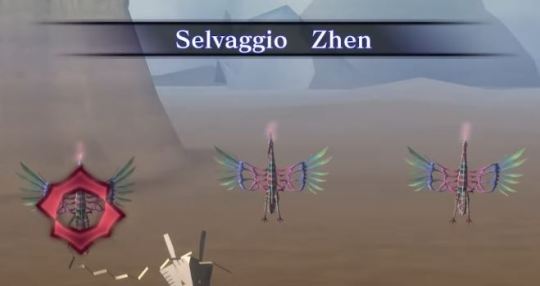
Wilder: Selvaggio (Wild). Not much to say. I like it better than the English one.

Fallen: Caduto (Fallen). It's the same term we use for "fallen angel" (angelo caduto), so it was pretty much the obvious and obviously correct choice.

Fairy: Fata (Fairy). It's pretty much only used for female entities, personally I think Folletto would've been more fitting. It refers to (mostly) mischievious little creatures (mostly) from european folklore.

Haunt: Spettro (Specter). Works fine.
That's all the races I could find. Orco definitely steals the spotlight for how interesting it is, but there's some more food for thought in there. I didn’t even consider the original Japanese names since the translation is based on the English script and we all know (?) how different the English names for races are from their Japanese counterparts.
Here's some more stuff unrelated to races:

Reason: Visione (Vision). I know it's not kotowari, but it works better than a more literal translation like Ragione would have. It's meant to be Vision as "an idea for the future". If I had to choose a term, I think I'd go with Principio, which means "beginning" and is also used for "moral principles". I really like Visione though.

Will o' Wisp: Will o' Wisp (Will o' Wisp). Dunno why they didn't change its name to "Fuoco fatuo", which is literally "Ignis fatuus" and is commonly used. Pretty weird. Plus, Jack-o'-Lantern has dashes. Will o' Wisp does not. I am going mad.

Demi-fiend: Mezzo-diavolo (lit. Half-devil). Obviously, they thought that the "Fiend" in Demi-fiend is the same as the Fiend race, and who wouldn't, just by looking at the English script? As for the "Mezzo": the "demi" in Demi-fiend comes from demigod, demi+god, which in Italian is semidio, semi+dio. Our "semi", however, is much more commonly used than the English "demi", so Semi-diavolo, Semi-demone or whatever would be nowhere near as "special" as Demi-fiend is. Mezzo-diavolo, on the other hand, loses that mythological appeal, but that "zz" makes it sound kinda derogatory, which I think is pretty fitting. It reminds me of mezzosangue (half-blood). I've seen some Italian fans hating this term with burning passion, but most of them would've probably hated every other choice as well.
In conclusion, I'm really glad we're finally getting translations, and so far they've been pretty good imho. I'd like them better if they were translated from the Japanese script, but that wouldn't really be an issue if the English translations were closer to the source material. In a post like this I'm obviously focusing on the "bad stuff", but all things considered, even if I wish we got something better, I'm pretty satisfied with the end result.
37 notes
·
View notes